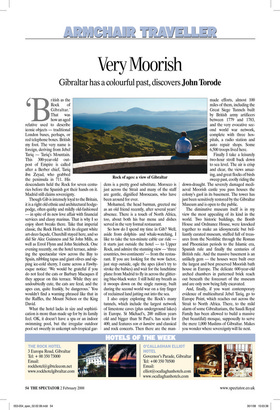Very Moorish
Gibraltar has a colourful past, discovers John Torode British as the Rock of Gibraltar.’ That was how an aged relative used to describe iconic objects — traditional London buses, perhaps, or red telephone boxes. British my foot. The very name is foreign, deriving from Jebel Tariq — Tariq’s Mountain. This 300-year-old outpost of Empire is called after a Berber chief, Tariq ibn Zeyad, who grabbed the peninsula in 711. His descendants held the Rock for seven centuries before the Spanish got their hands on it. Madrid still claims sovereignty.
Though Gib is intensely loyal to the Britain, it is a right old ethnic and architectural hodgepodge, often quirky and mildly old-fashioned — in spite of its new love affair with financial services and classy marinas. That is why I so enjoy short breaks there. Take that imperial classic, the Rock Hotel, with its elegant white art-deco façade, Churchill stayed here, and so did Sir Alec Guinness and Sir John Mills, as well as Errol Flynn and John Steinbeck. One evening recently, on the hotel terrace, admiring the spectacular view across the Bay to Spain, nibbling tapas and giant olives and sipping ice-cold sherry, I came across a Fawltyesque notice: ‘We would be grateful if you do not feed the cats or Barbary Macaques if they appear on this terrace. While they are undoubtedly cute, the cats are feral, and the apes can, quite frankly, be dangerous.’ You wouldn’t find a warning phrased like that in the Raffles, the Mount Nelson or the King David.
What the hotel lacks in size and sophistication is more than made up for by its family feel. OK, it doesn’t have a spa or an indoor swimming pool, but the irregular outdoor pool set sweetly in unkempt sub-tropical gar dens is a pretty good substitute. Morocco is just across the Strait and many of the staff are gentle, dignified Moroccans, who have been around for ever.
Mohamed, the head barman, greeted me as an old friend recently, after several years’ absence. There is a touch of North Africa, too, about both his bar menu and dishes served in the very formal restaurant.
So how do I spend my time in Gib? Well, aside from dolphinand whale-watching, I like to take the ten-minute cable car ride — it starts just outside the hotel — to Upper Rock, and admire the stunning view — ‘three countries, two continents’ — from the restaurant. If you are looking for the wow factor, just step outside, ogle the apes (don’t try to stroke the babies) and wait for the lunchtime plane from Madrid to fly in across the glittering blue-black water. I still hold my breath as it swoops down on the single runway, built during the second world war on a tiny finger of reclaimed land jutting out into the sea.
I also enjoy exploring the Rock’s many tunnels, which include the largest network of limestone caves (plus underground lakes) in Europe. St Michael’s, 200 million years old and bigger than St Paul’s, has seats for 400, and features son et lumière and classical and rock concerts. Then there are the man made efforts, almost 100 miles of them, including the Great Siege Tunnels built by British army artificers between 1779 and 1783, and the very evocative second world war network, complete with three hospitals, a radio station and auto repair shops. Some 6,500 troops lived here.
Finally I take a leisurely two-hour stroll back down to sea level. The air is crisp and clear, the views amazing, and great flocks of birds sweep past, coolly riding the down-draught. The severely damaged mediaeval Moorish castle you pass houses the colony’s gaol in its basement. The tower has just been sensitively restored by the Gibraltar Museum and is open to the public.
The diminutive museum itself is in my view the most appealing of its kind in the world. Two historic buildings, the Bomb House and Ordnance House, were knocked together to make an idiosyncratic but brilliantly curated museum, stuffed full of treasures from the Neolithic through the Roman and Phoenician periods to the Islamic era, Spanish rule and finally the centuries of British rule. And the massive basement is an unlikely gem — the houses were built over the largest and best preserved Moorish bath house in Europe. The delicate 600-year-old arched chambers in patterned brick reach out beneath the forecourt of the museum and are only now being fully excavated.
And, finally, if you want contemporary evidence of multicultural Jebel Tariq, go to Europe Point, which reaches out across the Strait to North Africa. There, to the mild alarm of some Gibraltarians, the Saudi Royal Family has been allowed to build a massive (but beautiful) mosque, supposedly to serve the mere 1,000 Muslims of Gibraltar. Makes you wonder where sovereignty will lie next.


































































 Previous page
Previous page